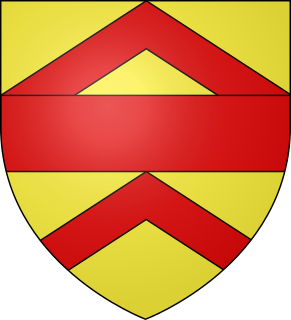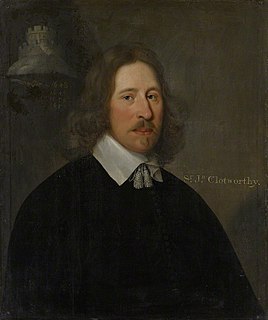
Baron de Ros of Helmsley is the premier baron in the Peerage of England, created in 1288/89 for William de Ros, with precedence to 24 December 1264. Premier baron is a designation and status awarded to the holder of the most ancient extant barony of the Peerage of England. The present premier baron is Baron de Ros. Before the Dissolution of the Monasteries the Prior of the Order of St John in England was deemed premier baron.

Viscount Cobham is a title in the Peerage of Great Britain that was created in 1718. Owing to its special remainder, the title has passed through several families. Since 1889, it has been held by members of the Lyttelton family.

Viscount Hereford is the oldest and only extant viscountcy in the Peerage of England, making the holder the Premier Viscount of England. The title was created in 1550 for Walter Devereux, 10th Baron Ferrers of Chartley.

Earl of Seafield is a title in the Peerage of Scotland. It was created in 1701 for James Ogilvy, who in 1711 succeeded his father as 4th Earl of Findlater. The earldoms of Findlater and Seafield continued to be united until 1811, when the earldom of Findlater became dormant, while the earldom of Seafield remains extant.

Earl Ferrers is a title in the Peerage of Great Britain. It was created in 1711 for Robert Shirley, 14th Baron Ferrers of Chartley. The Shirley family descends from George Shirley of Astwell Castle, Northamptonshire. In 1611 he was created a Baronet, of Staunton Harold in the County of Leicester, in the Baronetage of England. He was succeeded by his son Henry, the second Baronet, who married Lady Dorothy Devereux, daughter of Robert Devereux, 2nd Earl of Essex. On the death of her brother Robert Devereux, 3rd Earl of Essex, she became the youngest co-heir to the baronies of Ferrers of Chartley and the barony of Bourchier, which had fallen into abeyance on the death of the third Earl. Shirley was succeeded by his eldest son, the third Baronet. He died unmarried and was succeeded by his younger brother, the fourth Baronet. He was imprisoned in the Tower of London by Cromwell and died there in 1656. On his death the title passed to his eldest son, the fifth Baronet. He died at an early age and was succeeded at birth by his posthumous son, the sixth Baronet.

Baron Hastings is a title that has been created three times. The first creation was in the Peerage of England in 1290, and is extant. The second creation was in the Peerage of England in 1299, and became extinct on the death of the first holder in c. 1314. The third creation was in the Peerage of England in 1461, and has been in abeyance since 1960.

Baron FitzWalter is an ancient title in the Peerage of England. It was created on 24 June 1295 for Robert FitzWalter. The title was created by writ, which means that it can descend through both male and female lines. His great-grandson, the fourth baron, was an Admiral of the Fleet. The fourth baron's grandson, the sixth baron, died from dysentery at the siege of Harfleur. He was succeeded by his brother, the seventh baron, who was the last known male line descendant of Rollo of Normandy, was succeeded by his daughter and only child, Elizabeth. She was the wife of John Radcliffe. Their son, the ninth baron, was attainted for treason in 1495 with his title forfeited. However, his son Robert Radcliffe obtained a reversal of the attainder by Act of Parliament in 1509 and later served as Lord Lieutenant of Lancashire. He was created Viscount FitzWalter in 1525 and Earl of Sussex in 1529. His grandson, the third earl, was summoned to the House of Lords through a writ of acceleration in 1553 in his father's junior title of Baron FitzWalter. Lord Sussex later served as Lord Deputy of Ireland. He was succeeded by his younger brother, the fourth earl. He had earlier represented Maldon, Hampshire and Portsmouth in the House of Commons and also served as Lord Lieutenant of Hampshire. When he died the titles passed to his only child, the fifth earl. He was Lord Lieutenant of Essex.

Baron Clinton is a title in the Peerage of England. Created in 1298 for Sir John de Clinton, it is the seventh-oldest barony in England.

Baron de Clifford is a title in the Peerage of England. It was created in 1299 for Robert de Clifford (c.1274–1314), feudal baron of Clifford in Herefordshire, feudal baron of Skipton in Yorkshire and feudal baron of Appleby in Westmoreland. The title was created by writ, which means that it can descend through both male and female lines. The Norman family which later took the name de Clifford settled in England after the Norman Conquest of 1066 and was first seated in England at Clifford Castle in Herefordshire. The first Baron served as Earl Marshal of England but was killed at the Battle of Bannockburn in 1314. His 8th generation descendant the 11th Baron, was created Earl of Cumberland in 1525, whose grandson the 3rd Earl was a noted naval commander. On the latter's death in 1605 the earldom passed to his younger brother, the 4th Earl.

Baron Dacre is a title that has been created three times in the Peerage of England, every time by writ.

Viscount Massereene is a title in the Peerage of Ireland. It was created in 1660, along with the subsidiary title of Baron Loughneagh. From 1665 to 1816 the Skeffington Baronetcy of Fisherwick was attached to the viscountcy and from 1756 to 1816 the Viscounts also held the title of Earl of Massereene. Since 1843 the peerages are united with titles of Viscount Ferrard, of Oriel and Baron Oriel, both in the Peerage of Ireland, and Baron Oriel, in the Peerage of the United Kingdom. The Viscount also holds the subsidiary titles of Baron Loughneagh (1660) and Baron Oriel (1790) in the Peerage of Ireland and Baron Oriel (1821) in the Peerage of the United Kingdom. As Baron Oriel, he sat in the House of Lords until 1999.
Earl Rivers was an English title, which has been created three times in the Peerage of England. It was held in succession by the families of Woodville, Darcy and Savage.
The Baronetcy of Temple, of Stowe, in the Baronetage of England, was created on 24 September 1611 for Thomas Temple, eldest son of John Temple of Stowe, Buckinghamshire. His great-grandson Sir Richard, 4th Baronet, was created Baron Cobham on 19 October 1714, and Viscount Cobham and Baron Cobham on 23 May 1718, the latter with a special remainder, failing his male issue to his sisters and their heirs male. Upon his death on 13 September 1749, the barony of 1714 became extinct, the viscountcy and barony of 1718 passed to his elder sister, and the baronetcy passed to his second cousin once removed William Temple, of Nash House, who became 5th Baronet. On the death of Sir William's nephew Sir Richard Temple, 7th Baronet, on 15 November 1786, the baronetcy became dormant.

Earl Cowper was a title in the Peerage of Great Britain. It was created in 1718 by George I for William Cowper, 1st Baron Cowper, his first Lord Chancellor, with remainder in default of male issue of his own to his younger brother, Spencer Cowper. Cowper had already been created Baron Cowper of Wingham in the County of Kent, in the Peerage of England on 14 December 1706, with normal remainder to the heirs male of his body, and was made Viscount Fordwich, in the County of Kent, at the same time as he was given the earldom, also Peerage of Great Britain and with similar remainder. He was the great-grandson of William Cowper, who was created a Baronet, of Ratling Court in the County of Kent, in the Baronetage of England on 4 March 1642. The latter was succeeded by his grandson, the second Baronet. He represented Hertford in Parliament. He was succeeded by his eldest son, the aforementioned William Cowper, the third Baronet, who was elevated to the peerage as Baron Cowper in 1706 and made Earl Cowper in 1718. In 1706 Lord Cowper married as his second wife Mary Clavering, daughter of John Clavering, of Chopwell, County Durham.

Sir Charles Hanbury Williams, KB was a Welsh diplomat, writer and satirist. He was a Member of Parliament from 1734 until his death.
Thomas Coningsby, 1st Earl Coningsby PC of Hampton Court Castle, Herefordshire, was an English politician who sat in the House of Commons at various times from 1679 until 1716 when he was created a peer and sat in the House of Lords
Lawrence Harman Parsons, 1st Earl of Rosse, known as The Lord Oxmantown between 1792 and 1795 and as The Viscount Oxmantown between 1795 and 1806, was an Irish peer and politician.

Mary Capel, Countess of Essex, born Lady Mary Bentinck, was the daughter of William Bentinck, 1st Earl of Portland, a Dutch and English nobleman who became in an early stage the favourite of stadtholder William, Prince of Orange and his wife Anne Villiers.

George Capel-Coningsby, 5th Earl of Essex FSA was an English aristocrat and politician, and styled Viscount Malden until 1799. His surname was Capell until 1781.
Margaret Cecil, Countess of Salisbury, formerly Lady Margaret Manners, was the wife of James Cecil, 3rd Earl of Salisbury.











